语用学
- 格式:docx
- 大小:31.30 KB
- 文档页数:9
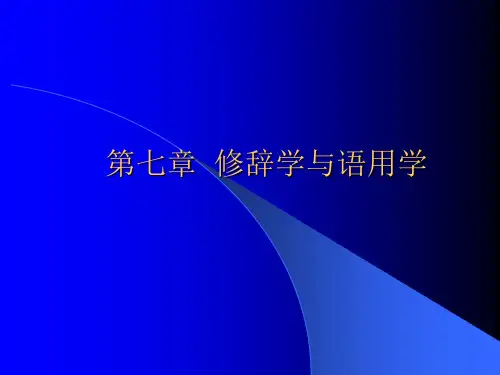
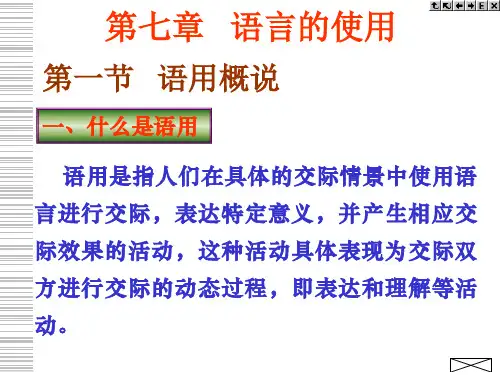
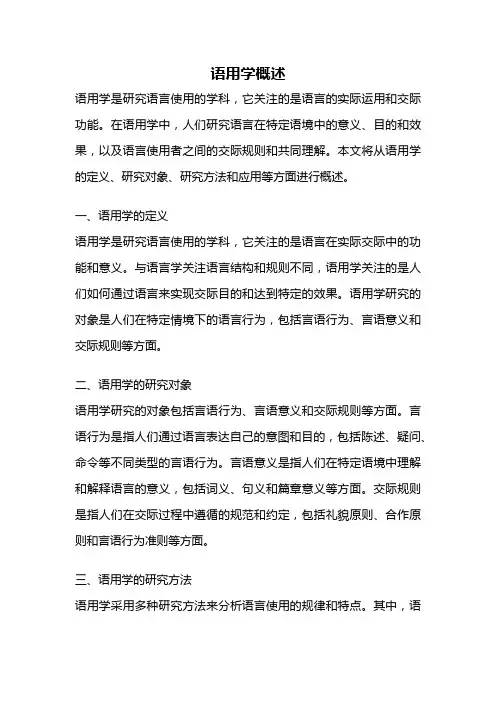
语用学概述语用学是研究语言使用的学科,它关注的是语言的实际运用和交际功能。
在语用学中,人们研究语言在特定语境中的意义、目的和效果,以及语言使用者之间的交际规则和共同理解。
本文将从语用学的定义、研究对象、研究方法和应用等方面进行概述。
一、语用学的定义语用学是研究语言使用的学科,它关注的是语言在实际交际中的功能和意义。
与语言学关注语言结构和规则不同,语用学关注的是人们如何通过语言来实现交际目的和达到特定的效果。
语用学研究的对象是人们在特定情境下的语言行为,包括言语行为、言语意义和交际规则等方面。
二、语用学的研究对象语用学研究的对象包括言语行为、言语意义和交际规则等方面。
言语行为是指人们通过语言表达自己的意图和目的,包括陈述、疑问、命令等不同类型的言语行为。
言语意义是指人们在特定语境中理解和解释语言的意义,包括词义、句义和篇章意义等方面。
交际规则是指人们在交际过程中遵循的规范和约定,包括礼貌原则、合作原则和言语行为准则等方面。
三、语用学的研究方法语用学采用多种研究方法来分析语言使用的规律和特点。
其中,语料库研究是一种重要的方法,通过收集和分析大量的真实语言数据来揭示语言使用的规律和变化。
实验研究是另一种常用的方法,通过设计实验来观察和分析人们在特定情境下的语言行为和反应。
此外,调查问卷、访谈和观察等方法也被广泛应用于语用学的研究中。
四、语用学的应用语用学在实际应用中具有广泛的价值和意义。
首先,语用学可以帮助人们更好地理解和解释语言的意义和用法,从而提高语言的有效性和准确性。
其次,语用学可以用于教育和教学领域,帮助学习者更好地掌握语言的交际功能和应用技巧。
此外,语用学还可以应用于语言教材的编写和语言测试的设计,以提高教学和评估的效果。
语用学是研究语言使用的学科,它关注的是语言的实际运用和交际功能。
语用学研究的对象包括言语行为、言语意义和交际规则等方面。
语用学采用多种研究方法来分析语言使用的规律和特点,其中包括语料库研究和实验研究等方法。
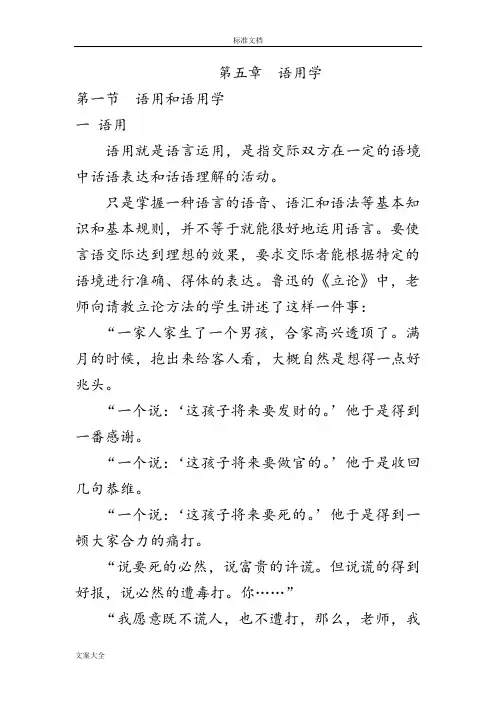
第五章语用学第一节语用和语用学一语用语用就是语言运用,是指交际双方在一定的语境中话语表达和话语理解的活动。
只是掌握一种语言的语音、语汇和语法等基本知识和基本规则,并不等于就能很好地运用语言。
要使言语交际达到理想的效果,要求交际者能根据特定的语境进行准确、得体的表达。
鲁迅的《立论》中,老师向请教立论方法的学生讲述了这样一件事:“一家人家生了一个男孩,合家高兴透顶了。
满月的时候,抱出来给客人看,大概自然是想得一点好兆头。
“一个说:‘这孩子将来要发财的。
’他于是得到一番感谢。
“一个说:‘这孩子将来要做官的。
’他于是收回几句恭维。
“一个说:‘这孩子将来要死的。
’他于是得到一顿大家合力的痛打。
“说要死的必然,说富贵的许谎。
但说谎的得到好报,说必然的遭毒打。
你……”“我愿意既不谎人,也不遭打,那么,老师,我得怎么说呢?”“那么,你得说:‘啊呀!这孩子呵!您瞧!多么……阿唷!哈哈!Hehe!he,hehehehe!’”言语交际不仅要求说话人对话语进行恰当的表达,还要求听话人对说话人的话语进行准确理解,唐代诗人杜甫的“朱门酒肉臭,路有冻死骨”中,“臭”字到底是什么意思?。
二语用学与相关学科语用学(pragmatics)研究在不同语境话语意义的恰当表达和准确理解,寻找并确立使话语意义得以恰当表达和准确理解基本规则和基本规律。
语用学源于哲学家对语言的探索。
语用学的概念首先是美国哲学家莫里斯(Charles Morris)提出。
他在1938念出版的《符号理论基础》一书中,提出符号学包括三个部分:句法学、语义学和语用学。
1977年在荷兰正式出版发行了《语用学杂志》(Journal of Pragmatics)之后,语用学才真正作为语言学的一门新兴分支学科而得到确认。
我国从20世纪70年代末引进语用学的理论,将西方的语用学理论方法和汉语的实际结合起来,将语用学和修辞学结合起来,对语言交际现象及其规律进行了广泛深入的研究。
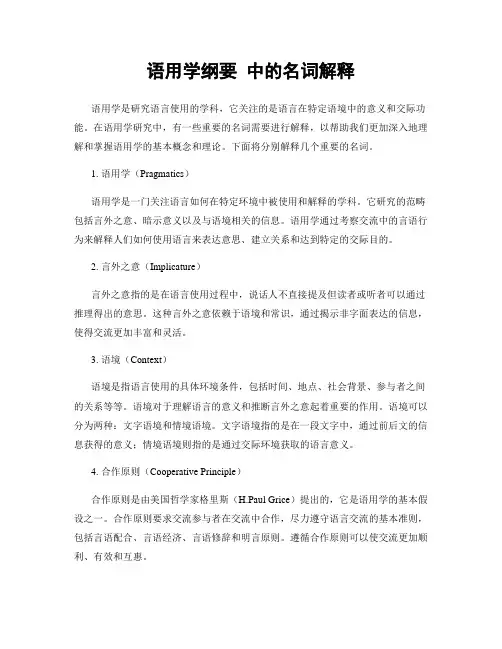
语用学纲要中的名词解释语用学是研究语言使用的学科,它关注的是语言在特定语境中的意义和交际功能。
在语用学研究中,有一些重要的名词需要进行解释,以帮助我们更加深入地理解和掌握语用学的基本概念和理论。
下面将分别解释几个重要的名词。
1. 语用学(Pragmatics)语用学是一门关注语言如何在特定环境中被使用和解释的学科。
它研究的范畴包括言外之意、暗示意义以及与语境相关的信息。
语用学通过考察交流中的言语行为来解释人们如何使用语言来表达意思、建立关系和达到特定的交际目的。
2. 言外之意(Implicature)言外之意指的是在语言使用过程中,说话人不直接提及但读者或听者可以通过推理得出的意思。
这种言外之意依赖于语境和常识,通过揭示非字面表达的信息,使得交流更加丰富和灵活。
3. 语境(Context)语境是指语言使用的具体环境条件,包括时间、地点、社会背景、参与者之间的关系等等。
语境对于理解语言的意义和推断言外之意起着重要的作用。
语境可以分为两种:文字语境和情境语境。
文字语境指的是在一段文字中,通过前后文的信息获得的意义;情境语境则指的是通过交际环境获取的语言意义。
4. 合作原则(Cooperative Principle)合作原则是由美国哲学家格里斯(H.Paul Grice)提出的,它是语用学的基本假设之一。
合作原则要求交流参与者在交流中合作,尽力遵守语言交流的基本准则,包括言语配合、言语经济、言语修辞和明言原则。
遵循合作原则可以使交流更加顺利、有效和互惠。
5. 指代(Reference)指代是指使用语言中的词语来指称现实世界中的事物、概念或实体。
在语用学中,指代研究包括指代的语用功能、指代的形式选择以及指代的语境依赖性等等。
指代在交际中起着很重要的作用,识别和理解指代可以帮助我们构建语言信息的连贯性和完整性。
6. 指涉(Deixis)指涉与指代类似,但更加具体,它指的是在交际中通过语言指示和引用特定的人、事、物或地点。
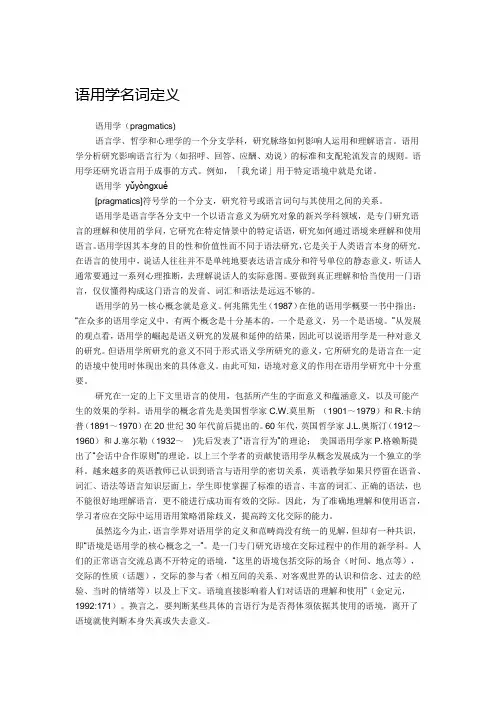
语用学名词定义语用学(pragmatics)语言学、哲学和心理学的一个分支学科,研究脉络如何影响人运用和理解语言。
语用学分析研究影响语言行为(如招呼、回答、应酬、劝说)的标准和支配轮流发言的规则。
语用学还研究语言用于成事的方式。
例如,「我允诺」用于特定语境中就是允诺。
语用学yǔyòngxué[pragmatics]符号学的一个分支,研究符号或语言词句与其使用之间的关系。
语用学是语言学各分支中一个以语言意义为研究对象的新兴学科领域,是专门研究语言的理解和使用的学问,它研究在特定情景中的特定话语,研究如何通过语境来理解和使用语言。
语用学因其本身的目的性和价值性而不同于语法研究,它是关于人类语言本身的研究。
在语言的使用中,说话人往往并不是单纯地要表达语言成分和符号单位的静态意义,听话人通常要通过一系列心理推断,去理解说话人的实际意图。
要做到真正理解和恰当使用一门语言,仅仅懂得构成这门语言的发音、词汇和语法是远远不够的。
语用学的另一核心概念就是意义。
何兆熊先生(1987)在他的语用学概要一书中指出:―在众多的语用学定义中,有两个概念是十分基本的,一个是意义,另一个是语境。
‖从发展的观点看,语用学的崛起是语义研究的发展和延伸的结果,因此可以说语用学是一种对意义的研究。
但语用学所研究的意义不同于形式语义学所研究的意义,它所研究的是语言在一定的语境中使用时体现出来的具体意义。
由此可知,语境对意义的作用在语用学研究中十分重要。
研究在一定的上下文里语言的使用,包括所产生的字面意义和蕴涵意义,以及可能产生的效果的学科。
语用学的概念首先是美国哲学家C.W.莫里斯(1901~1979)和R.卡纳普(1891~1970)在20世纪30年代前后提出的。
60年代,英国哲学家J.L.奥斯汀(1912~1960)和J.塞尔勒(1932~)先后发表了―语言行为‖的理论;美国语用学家P.格赖斯提出了―会话中合作原则‖的理论。
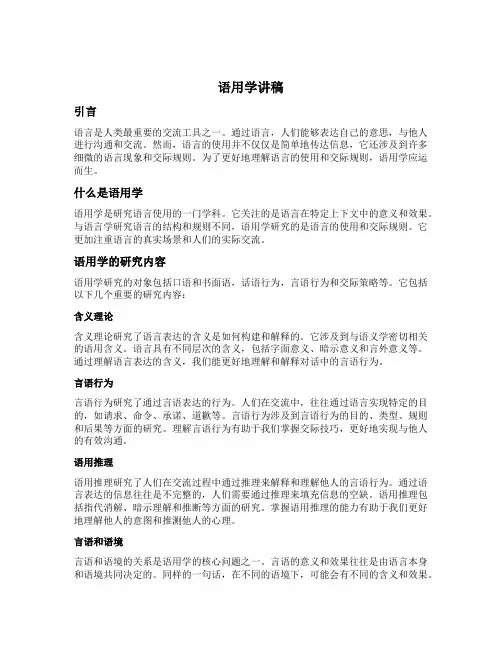
语用学讲稿引言语言是人类最重要的交流工具之一。
通过语言,人们能够表达自己的意思,与他人进行沟通和交流。
然而,语言的使用并不仅仅是简单地传达信息,它还涉及到许多细微的语言现象和交际规则。
为了更好地理解语言的使用和交际规则,语用学应运而生。
什么是语用学语用学是研究语言使用的一门学科。
它关注的是语言在特定上下文中的意义和效果。
与语言学研究语言的结构和规则不同,语用学研究的是语言的使用和交际规则。
它更加注重语言的真实场景和人们的实际交流。
语用学的研究内容语用学研究的对象包括口语和书面语,话语行为,言语行为和交际策略等。
它包括以下几个重要的研究内容:含义理论含义理论研究了语言表达的含义是如何构建和解释的。
它涉及到与语义学密切相关的语用含义。
语言具有不同层次的含义,包括字面意义、暗示意义和言外意义等。
通过理解语言表达的含义,我们能更好地理解和解释对话中的言语行为。
言语行为言语行为研究了通过言语表达的行为。
人们在交流中,往往通过语言实现特定的目的,如请求、命令、承诺、道歉等。
言语行为涉及到言语行为的目的、类型、规则和后果等方面的研究。
理解言语行为有助于我们掌握交际技巧,更好地实现与他人的有效沟通。
语用推理语用推理研究了人们在交流过程中通过推理来解释和理解他人的言语行为。
通过语言表达的信息往往是不完整的,人们需要通过推理来填充信息的空缺。
语用推理包括指代消解、暗示理解和推断等方面的研究。
掌握语用推理的能力有助于我们更好地理解他人的意图和推测他人的心理。
言语和语境言语和语境的关系是语用学的核心问题之一。
言语的意义和效果往往是由语言本身和语境共同决定的。
同样的一句话,在不同的语境下,可能会有不同的含义和效果。
语用学研究了语言表达和语境之间的关系,包括语境的角色、语境对语言理解的影响等方面。
语用学的应用语用学不仅仅是一门学术研究,它还具有广泛的应用价值。
在日常生活中,掌握语用学的原理和方法有助于我们提高交际技巧,避免沟通误解和冲突。
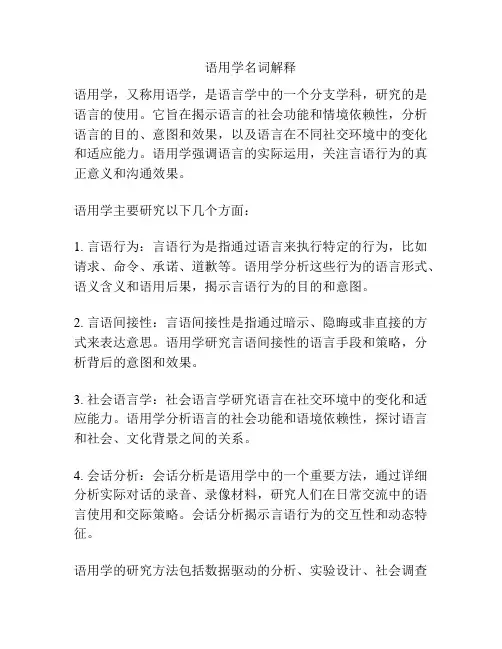
语用学名词解释语用学,又称用语学,是语言学中的一个分支学科,研究的是语言的使用。
它旨在揭示语言的社会功能和情境依赖性,分析语言的目的、意图和效果,以及语言在不同社交环境中的变化和适应能力。
语用学强调语言的实际运用,关注言语行为的真正意义和沟通效果。
语用学主要研究以下几个方面:1. 言语行为:言语行为是指通过语言来执行特定的行为,比如请求、命令、承诺、道歉等。
语用学分析这些行为的语言形式、语义含义和语用后果,揭示言语行为的目的和意图。
2. 言语间接性:言语间接性是指通过暗示、隐晦或非直接的方式来表达意思。
语用学研究言语间接性的语言手段和策略,分析背后的意图和效果。
3. 社会语言学:社会语言学研究语言在社交环境中的变化和适应能力。
语用学分析语言的社会功能和语境依赖性,探讨语言和社会、文化背景之间的关系。
4. 会话分析:会话分析是语用学中的一个重要方法,通过详细分析实际对话的录音、录像材料,研究人们在日常交流中的语言使用和交际策略。
会话分析揭示言语行为的交互性和动态特征。
语用学的研究方法包括数据驱动的分析、实验设计、社会调查和语料库语言学等。
研究者通过收集和分析大量的实际语言数据,探索语言与社会、文化、认知等各个层面的关系。
语用学的应用领域广泛,包括教育、广告、政治演讲、司法审理等。
在教育中,语用学可以帮助教师提高教学效果,培养学生的语用意识和语言运用能力。
在广告中,语用学可以帮助广告商理解消费者的语言需求,设计更具说服力和吸引力的广告语言。
在政治演讲和司法审理中,语用学可以帮助分析演讲者或律师的措辞选择和表达方式,揭示其中的意图和效果。
总之,语用学研究语言的使用方面,揭示言语行为的目的、意图和效果,分析语言的适应性和变化性。
它不仅帮助我们更好地理解语言的功能和社会意义,也为语言教学、社交交际和语言政策提供了有益的参考。
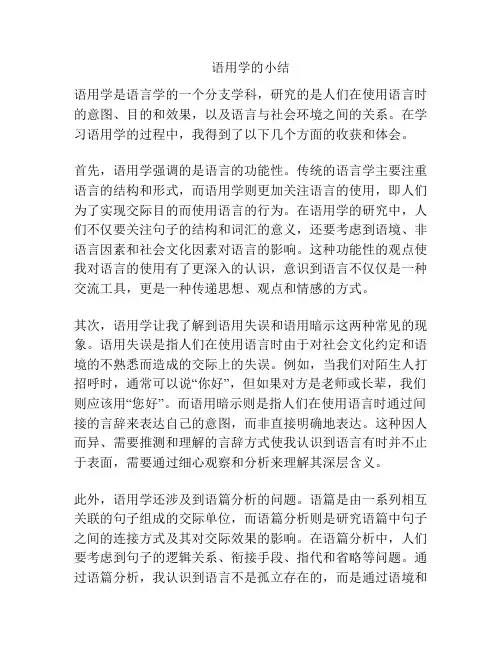
语用学的小结语用学是语言学的一个分支学科,研究的是人们在使用语言时的意图、目的和效果,以及语言与社会环境之间的关系。
在学习语用学的过程中,我得到了以下几个方面的收获和体会。
首先,语用学强调的是语言的功能性。
传统的语言学主要注重语言的结构和形式,而语用学则更加关注语言的使用,即人们为了实现交际目的而使用语言的行为。
在语用学的研究中,人们不仅要关注句子的结构和词汇的意义,还要考虑到语境、非语言因素和社会文化因素对语言的影响。
这种功能性的观点使我对语言的使用有了更深入的认识,意识到语言不仅仅是一种交流工具,更是一种传递思想、观点和情感的方式。
其次,语用学让我了解到语用失误和语用暗示这两种常见的现象。
语用失误是指人们在使用语言时由于对社会文化约定和语境的不熟悉而造成的交际上的失误。
例如,当我们对陌生人打招呼时,通常可以说“你好”,但如果对方是老师或长辈,我们则应该用“您好”。
而语用暗示则是指人们在使用语言时通过间接的言辞来表达自己的意图,而非直接明确地表达。
这种因人而异、需要推测和理解的言辞方式使我认识到语言有时并不止于表面,需要通过细心观察和分析来理解其深层含义。
此外,语用学还涉及到语篇分析的问题。
语篇是由一系列相互关联的句子组成的交际单位,而语篇分析则是研究语篇中句子之间的连接方式及其对交际效果的影响。
在语篇分析中,人们要考虑到句子的逻辑关系、衔接手段、指代和省略等问题。
通过语篇分析,我认识到语言不是孤立存在的,而是通过语境和上下文联系在一起的,并能够产生更丰富和准确的意义。
最后,语用学强调理解和交际的能力。
在语用学的研究中,人们不仅要从发话人的角度来分析语言使用的意图和效果,还要从听话人的角度来理解和解读语言的含义。
因此,语用学注重培养学习者的语言推理、推断和解码能力,以提高他们的语言理解和交际技能。
通过语用学的学习,我更加关注对语言背后的意图和目的的把握,也更加重视在日常交际中的表达和理解。
综上所述,语用学的学习让我认识到语言不仅仅是一种工具,更是人们交流、思考和表达的方式。
![语用学笔记[教学]](https://uimg.taocdn.com/e53b856e1611cc7931b765ce0508763231127415.webp)
语用学笔记一基础知识一语用学定义1 Levinson关于语用学的9个定义及批评2 定义:语用学研究在不同语境中话语意义的恰当表达和准确理解,寻找并确立使上述目标的基本原则和准则。
二语用学的由来、产生与发展1提出:语用学(Prgmtics)这一术语最早是由美国哲学家(C.W.Morris)于1938年在其专著《符号理论基础》(oundtions o the Theory o Signs)提出。
他指出符号学(Semiotics)包括三部分,即:句法学(Syntx)、语义学(Semntics)和语用学(Prgmtics)。
其中:1)句法学:研究“符号之间的形式关系”;2)语义学:研究“符号及其所指对象的关系”;3)语用学:研究“符号与解释者interpreters(后改为使用者users)之间的关系”2 发展:1)语言哲学家B r·Hillel提出语用学的具体研究对象是指引词语(indexic l expressions);2)英国哲学家奥斯丁(tin)和塞尔(J.Serle)的言语行为理论(Speech-cts Theory);3)美国哲学家格赖斯(H.P.Grice)的会话含义理论(Converstionl Implicture)及合作原则();4)列文森(S.C.Levinson)的《语用学》(Prgmtics);5)利奇(G.N.Leech)的语用原则(Principles o Prgmtics);6)Wilso n﹠Sperber的关联理论(Relevnce Theory);7)范叔伦(V erschueren)的语言适应理论(Theory o Linguistic dpttion)及综合论();8)新格赖斯会话机制(Neo-Gricen Prgmtic pprtus);9)范叔伦(V erschueren)的统一理论框架(Coherent Theoreticl rmework)三结构主义语言学的功过1 区分语言(lngue)和言语(prole),指出语言是语言学真正的研究对象;区分内部要素和外部要素,主张就语言而研究语言;.de.Sussure 区分共时状态(synchronic)和历时状态(dichronic),认为共时状态的语言系统是语言研究的重点;提出语言系统共时描写的理论和方法。
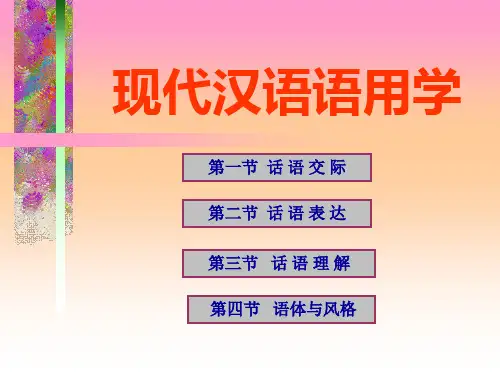
语言学语用学语言学是研究语言本质、结构、功能和发展规律的学科,而语用学则是语言学的一个重要分支,主要研究语言的使用情境以及语言的意义、目的和效果等方面的问题。
本文将从理论与应用两个方面来探讨语言学语用学的重要性以及其在现实生活中的应用。
一、语言学语用学概述语用学的概念最早由英国的奥斯汀(Austin)和格里斯(Grice)提出,并在之后的研究中得到了进一步的发展和完善。
它强调语言是一种社会交往工具,语言的意义取决于具体的使用情境,同时还包括承担对话行为和推理的方式等方面的研究内容。
语用学旨在探索语言的各种功能和语言使用者之间的交际关系。
它不仅关注语言和社会文化之间的关系,还关注语言和语境之间的关系,语言的真实意义往往是依赖于具体的使用背景和交际目的的。
语言学语用学的研究内容包括语篇分析、言外之意、语言行为和交际策略等多个方面。
二、语言学语用学的研究方法语言学语用学的研究方法多样,包括实证研究、分析对话语篇、观察自然语言使用、社会语言学调查等等。
这些方法为我们深入理解语言的实际运用提供了重要的手段和途径。
实证研究是语用学的重要研究方法之一,通过实际的调查和实验证据来验证语用学的理论假设,以此增进我们对语言使用的认识和理解。
研究者可以通过设计语用学实验,收集和分析实验数据,并得出相关的结论和发现。
这种实证研究的结果对于促进语用学理论的发展和应用具有重要的意义。
除了实证研究方法外,分析对话语篇也是语言学语用学的常用手段。
通过对实际对话语篇的分析和解读,揭示其中的言外之意和交际策略,深入了解语言使用者之间的相互关系和交流方式。
这种分析对话语篇的方法可以帮助我们更好地理解和解释语言使用的背后意义和动机。
另外,观察自然语言使用和进行社会语言学调查也是语用学的重要研究方法。
通过观察和记录真实的语言使用情景,研究者可以获取大量的语用学素材,并从中分析和总结规律和特点,进一步验证和探索语用学的相关理论和观点。
三、语言学语用学的应用价值语言学语用学不仅具有理论上的重要性,而且在现实生活中也具有广泛的应用价值。
语用学概述语用学是语言学的一个分支,研究语言使用的规则和特点。
它关注的是人们在使用语言时所表达的意义和目的,以及语言背后的社会文化背景和交际情境。
语用学的研究对象是语言的意义和功能,它不仅仅关注语言的结构和形式,还关注语言在实际交流中的应用和效果。
语用学主要研究以下几个方面:1. 语言交际行为:语用学研究语言交际的各个方面,包括言语行为、语用规则、言语行为的意义和效果等。
它探讨人们在交流中是如何使用语言,通过语言表达自己的意思,并与他人进行有效的沟通。
2. 言外之意:语用学关注的不仅仅是字面意义,还包括言外之意。
人们在交流中常常使用间接语言表达自己的意图,通过隐喻、比喻、讽刺等手法来传递信息。
语用学研究这些言外之意的表达方式和解读方法。
3. 语境和交际情境:语用学强调语言使用的背景和环境对语言意义的影响。
同样的一句话,在不同的语境下可能会有不同的解读。
语用学研究语言使用者如何根据交际情境来理解和运用语言。
4. 社会文化因素:语用学认为语言使用是受到社会文化因素的影响的。
不同的文化背景和社会习惯可能导致人们在交流中使用不同的语言策略和表达方式。
语用学研究这些社会文化因素对语言使用的影响。
语用学的研究方法主要包括对真实语言数据的分析和实验研究。
通过对真实语言数据的分析,研究者可以发现语言使用的规律和特点。
而实验研究则可以通过控制变量来验证语用学理论的有效性。
语用学的研究对于语言教学和语言技能的培养具有重要意义。
了解语言使用的规则和特点,可以帮助学习者更好地理解和运用语言。
例如,在教授外语时,教师可以教授学习者如何根据交际情境来选择和运用语言,以及如何理解和解读言外之意。
同时,语用学的研究也对翻译、口译等语言相关的职业有一定的指导作用。
语用学是语言学中的一个重要分支,它研究语言使用的规则和特点。
通过研究语言交际行为、言外之意、语境和交际情境、社会文化因素等方面,语用学帮助我们更好地理解和运用语言。
它对语言教学和语言技能的培养具有重要意义,同时也对其他语言相关的研究和职业有一定的指导作用。
汉语文化语用学汉语文化语用学什么是语用学?•语用学(Pragmatics)是研究语言和使用语言的关系的学科。
•语用学研究语言在实际使用中的意义、目的和效果。
语用学在跨文化交际中的重要性•种种文化背景导致了不同语言之间的差异。
•跨文化交际中,对语言背后的文化理解至关重要。
汉语文化语用学的研究领域•礼貌原则:汉语中的礼貌用语和礼仪规范。
•语言行为:汉语中的陈述、问句、命令等语言行为。
•谦辞原则:汉语中的谦虚语和尊敬语的运用。
•语境分析:汉语中的语境对语义和语用的影响。
•文化因素:汉语中的文化价值观对语用的影响。
汉语文化语用学的应用•教育和文化交流:帮助外国人理解中国文化和汉语。
•商务交流:减少文化误解,促进商务合作。
•社会交际:提升跨文化交际能力,避免冲突。
汉语文化语用学的挑战和解决方案•挑战:汉语的语义含混和多义性。
•解决方案:通过学习实践、交流和文化体验来培养语用能力。
结论汉语文化语用学的研究在促进跨文化交际和跨文化理解中起到重要的作用。
通过了解汉语的语用规范和文化背景,我们能够更好地与中国人进行沟通和合作。
在全球化的背景下,学习汉语文化语用学是非常有价值的。
汉语文化语用学的应用案例教育和文化交流•在对外汉语教学中,教师可以通过教授汉语文化语用学知识,帮助学生更好地理解中国文化和汉语的语用规范。
•文化交流活动中,了解汉语的礼仪规范和语言使用习惯,可以避免文化冲突和误解,促进友好交流。
商务交流•在商务环境中,了解汉语的谦辞原则和尊敬语的运用,能够增进商务合作的信任和亲近感。
•熟悉汉语中的礼貌用语和商务礼仪,能够在商务谈判和会议中更加得体地表达意见和展示自己的尊重。
社会交际•在与中国人的社交场合中,了解汉语中陈述、问句和命令等语言行为的特点,能够更好地理解他们的意图和表达方式。
•通过学习汉语的语境分析,可以更准确地解读中国人的暗示和含义,避免因语言误解而产生不必要的冲突。
汉语文化语用学的挑战和解决方案挑战•汉语的语义含混和多义性给语用学研究带来了困难。
第六章语用学1.什么是语用学1.1定义语用学研究的是语言使用者是如何使用句子成功进行交际的。
它不是孤立地去研究语义,而是把语义置于使用语境中去研究的一门学科。
1.2语用学和语义学语用学和语义学既有相关性又有相异性。
两者都是对意义的研究。
传统语义学把语义看成是抽象的,内在的,是语言本身的特性,不受语境的影响。
因此传统语义学只研究语义的内在特征,不把语义研究置于语境中来考察。
语用学研究的是交际过程中语言意义的表达和理解。
语用学家认为不把意义放在语境中来考虑就不可能对语义进行充分的描述,因此在研究语义时是否考虑语境便成了传统语义学和语用学的根本区别所在。
1.3语境语境是交际双方共有的知识,它包括双方具有的语言知识以及有关客观世界的知识,而客观世界的知识又包括有关世界的常识性知识以及交际发生的实际情景知识。
1.4句子意义和话语意义句子是语法单位。
当把句子用在实际交际中时,句子便成了话语。
句子意义是抽象的,是句子的语义内容,它孤立于语境之外;话语意义是具体的,它基于句子意义与语境的结合,是句子意义在特定语境中的具体化,体现了说话人的意图和目的。
由于话语语义是句子意义与语境结合的结果,话语语义要比句子的语义丰富得多。
如:”You are a machine.”句子的意思是“你是机器。
”,但是一旦与具体的语境相结合,就会产生不同的话语语义,如说话人可能是说听话人没有情感,或说听话人不知疲倦地工作,或者说听话人做事比较机械等。
大部分话语在语法形式上与句子相吻合,但是也有一些话语在语法上是不完整的,有些甚至不能还原为完整的句子。
如,语言使用者在特定的语境中可以使用话语” The door, please!”去行使关门的请求。
像“Hi!”和“Ouch!”这样的话语很难还原成语法完整的句子。
2.言语行为理论英国哲学家奥斯汀在20世纪50年代末提出了言语行为理论。
在他的言语行为理论中,奥斯汀区分了言有所述(constative)和言有所为(performative)。
Contrastive Study of the First Person Deixis in English and ChineseAbstract: Person deixis concerns the encoding of the role of participants in the speech Event in which the utterance in question is delivered. And they are widely used in English and Chinese. This thesis through the contrastive study on the pragmatic function of the first person in English and Chinese, similarities and differences in the first person deixis use between the two language can be analyzed. Key words: person deixis, the first person deixis, pragmatic meaning, contrastive analysis摘要: 人称指示是指说话者在言语活动中解码言语信息. 人称指示在英汉两种语言中都有着较高的使用频率.本文通过对英汉第一人称指示语的语用功能对比分析, 发掘英汉两种语言第一人称指示方面的异同点.关键词: 人称指示语第一人称指示语语用意义英汉对比1.InductionDeixis are those words in a language that entirely depend on text(Fromkin et.al.1991). Deixis is the earliest research object of pragmatic, because it directly links to language structure and context. Therefore, people think deixis plays a crucial role in language expression and understanding. Traditionally, deixis were divided into three categories-referring to people, place and time. By the 1980‟s, two more categories had been added-discourse and social deixis (Levinson,1983). In addition to discourse deixis, the different types of deixis can express interpersonal meaning, and actualize a certain communicative function. Both time and place deixis can transfer deictic center to the addressee, which express the respect to the hearer. Social deixis attach great importance on the function of interpersonal meaning.This thesis focuses on the social and Pragmatic meanings of English and Chinese deixis.Through the contrastive study on the Pragmatic functions of Person deixis in English and Chinese, similarities and differenees in the Person deixis use Between the two languages can be analyzed.2.Person Deixis in EnglishPerson deixis is an important component of pragmatics. With reference to the addresser, the addressee and the third party involved in a conversation, person deixis indicate the social status, interpersonal relationship and other factors of the conversation parties.2.1 The first Person deixisThe first person is an item that is used to refer to the addresser of an utterance or the sender of the message. The first Person deictic items have both the singular and Plural forms, i.e.I and we, and eaeh form has variations in case, i.e.me vs. us for the objective case and my vs.our for the Possessive case.2.1.1 The first Person singular form IThe first Person singular, which will be used in both formal and informal Linguistic styles, refers to the sender of a message. The reference of the first Person Singular is clear and specified.Firstly, I is used to refer to the addresser himself/herself and to emphasize that the opinion expressed is the addresser‟s own opinion.Secondly, I is often used when one tells good and Pleasant news.Thirdly, when I is used with other person deietic items in one sentence,different positions of I will imply the addresser‟s different intentions. For example,a. I and She do the same wrong.b.She and I have got the teac her‟s praise.In the first sentence, it shows the addresser intends to bear the consequences of the mistake made by both, However, in the second sentence, I put at a secondary position to show the modesty of the addresser while when it comes to honor.Another example:a.I do not believe Mr. John will do such thing.b.I am glad to hear that you pass do it by yourself.In a, I expresses the addresser‟ own opini on according to his konwledge about Mr.John. He don not think Mr. John will do such thing. The addresser takes the responsibility for his attitude. And it same as b, the spearker satified with the hearer‟ action, so he use I to show the praise comes out spontaneously. The praise is the speaker‟s own attitude other than anyone else‟s.2.1.2 The first Person Plural form weThere are two major uses of we: inclusive and exclusive. Inclusive we is also called we-inclusive-of-addressee, and we- exclusive-of-addressee. “Inclusive we is a powerful emotional force, bringing addresser and hearer together as one, united and sharing common interest.”(Lakeoff,1990:190) If the speaker use inclusive, he intends to shorten the distance between himself and the hearer or create a friendly atmosphere. Inclusive we is commonly used when the speaker gives some suggestions, for example,Shall we go swimming?The addressee puts forward a suggestion by using an interrogative sentence with inclusive we, which makes the speaker‟s attitude more friendly, and the hearer will think that his/her response is very important to the speaker. So the communication will be more effective and smooth.We-exclusive-of addressee can often be found in the report or newspaper, which shows the modest attitude of addressee. Some uses of we and our have been associated with the assertive or direetive force of utterances, which they serve to soften or mitigate(Marmaridou,2000:76)In communication, both inclusive and exclusive can be used. Lakeoff used a speech of president Reagan an example to demostrate it. “By beginning to rebuild our defense , we have restored credible deterrence and can confidently seek a secure and lasting peace, as well as a reduction of arms. As I said Wednesday night, American is back and standing tall. we‟ve begun to restore great American values: the dignity of work, the warmth of family, the strength of neighborhood and the nourishment of human freedom. But our work is not finished.”In the speech, if the hearer do not consider the context, they do not know what “we” and “our” refer to. In fact, “we” and “our” refer to American government or American or both. Reagan use “we” and“our” in his speech in order to let American make an agreement wirh America government.3.Person Deixis in ChineseThe first person deixis in Chinese includes wo(我),wo-men(我们),zan(咱)and Zan-men(咱们). wo/zan are the singular forms referring to the addresser himself/herself; wo-men/zan- men are the plural forms referring to an entity of a plural number inclusive of the addresser.wo/wo- men are used in both written and oral forms; while zan/zan- men are more frequently used in oral communieation, especially in northem dialeets, but is rarely used in southem dialeets. “Zan is far more colloquial, and is most commonly used in northern Chinese dialects”(Wei,2002). Wei also points out that “Zan has a specific pragmatic function, and is normally used between friends. Used to show trust, it can therefore reduce social distance between the addresser and the addressee”.3.1 The first person singular form woAccording to Tian Hailong(2001), when a addresser uses wo in self-reference, he is self-confident and ready to take the responsibility for his utterance or behavior. Sometimes wo is used in place of wo-men. This use usually appears in slogan(Xiao Chaohong, Liu Luying, Li Tianmei,2003). By using wo, the structure of the sentence becomes more concise, and the tone becomes more forceful. For example:a.你大国敢不仁,我小国也敢不义!b.还我河山3.2 The first person singular form zanCompared with wo, the use of zan has more pragmatic meaning. Zan can refer to both the addresser and the addressee, but the addresser tends to use zan to indicate himself. When zan is used, the addresser intends to show an intimate relationship with the addressee. For instance:a.要说当经理,咱哥们儿也行。